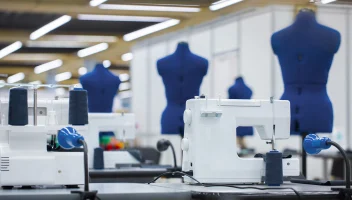5 Ways Technology Alleviates Common Supply Chain Problems for Fashion Brands
5 Ways Technology Alleviates Common Supply Chain Problems for Fashion Brands
5 Ways Technology Alleviates Common Supply Chain Problems for Fashion Brands
30 Sep 2019
Aptean Staff Writer
Apparel and home goods customers have a greater number of brand and product choices than ever before in history. So it’s critical that brands can deliver the right products at the right time to capitalize on tastes and trends. The supply chain affects both customer experience and the bottom line, so let’s examine some of the ways technology can make a positive impact on fashion supply chains and avoid some common supply chain problems.
The Danger of a Fragile Supply Chain
A weak supply chain can disrupt your plans to deliver products to the marketplace, jeopardizing your relationships with key customers and putting your business at risk of getting stuck with out-of-trend, unwanted inventory. Deliver late orders or inconsistent quality products because you lacked inventory or your vendors failed you, and you might soon find your own customers seeking an alternate supplier. Repairing a damaged relationship is never as good as maintaining a positive one—and recovery issues can be costly when mistakes have been made.
1. Gain Real-Time Visibility Across the Supply Chain
Having an integrated technology platform that brings together information about customers, orders, products, vendors, and inventory can help you achieve visibility across your supply chain. This has many implications for running a fashion brand more efficiently. Real-time insight can enable you to do better forecasting and spot potential supply chain problems before they materialize. When issues do arise, you will react more quickly and improve relationships with partners and customers by being more transparent. Real-time visibility into the supply chain starts with the Enterprise Resource Planning (ERP) system. It serves the central data hub of your integrated supply chain platform.
2. Stay Agile by Modeling ‘What-If’ Scenarios
A lot of things can happen between the time a design is ready for manufacturing and when you receive finished goods into inventory. Problems at ports and borders can create logistical challenges. Natural disasters such as tsunamis, earthquakes and typhoons can destroy production facilities. In the global economy, fluid geopolitical situations and changing trade agreements can impact whether it makes sense to produce in different regions. For example, Bangladesh, Vietnam and other Asian nations to adjust to the growing tariffs in the trade conflict between the US and China.
A real-time supply chain platform can enable you model what-if scenarios, so that you know how you will respond to changing business conditions. For example, it can help you:
Decide where to manufacture based on border conditions, logistics and tariffs.
Adjust for transient problems in the supply chain, for example bad weather or a worker strike, by expediting shipping or negotiating a different pay rate.
Choose vendors based on past results and current supplies and pricing.
Make adjustments to production orders based on demand from your retailers.
3. Shorten Time From Design to Delivery
Top fast fashion retailers deliver lucrative, on-trend products to market in about two weeks, compared to the traditional six to nine month lifecycles. Brands with better-than-average supply chain visibility through technology enjoy more opportunities to profit from changing trends than supply chain laggards. To move this quickly, brand owners use Product Lifecycle Management (PLM) software to accelerate design, development and sourcing while fostering greater supply chain collaboration. PLM helps brands streamline approvals, change management, line selection, vendor quotes and bids, compliance and other global processes.
4. Improve Vendor Management and Communication
Speeding up the supply chain and improving quality requires excellent relationships with your vendor partners. Vendor Portal technology makes it easy to communicate and collaborate in real-time or near real-time with vendors around the world. You can give vendors anytime access to tech packs, product documents, product or sample images, and order information. A Vendor Portal helps brands automate procurement and bidding, track supply chain stages, and eliminate mistakes and miscommunications that arise from communicating through email and spreadsheets.
5. Take Control of Global Inventory and Reduce Over-Ordering
No brand wants to dampen customer engagement and enthusiasm by having enough apparel ready to satisfy demand, so overproduction is rampant. According to fashion sustainability consultant Hasmik Matevosyan, 30% of clothes produced are never sold, another 30% must be deeply discounted, and 15% of materials remain in the factory due to production mistakes and cutting waste. It all adds up to an industry that is currently the second most polluting on the planet (after the energy industry).
When you lack real-time visibility into inventory, over-ordering creates excess inventory that is often unloaded in unsustainable ways, from deep discounting to burning/shredding deadstock. Research has shown that consumers care about the environmental issues associated with fashion; according to Hitwise, “19% of the top fast fashion related searches were about the environment, ethics and sustainability.”
Warehouse Management Systems (WMS) provide complete visibility into inventory levels of production supplies and finished garments. Shop Floor Control technology delivers visibility into production lines and WIP, whether manufacturing takes place at an internal facility or a vendor. Shop Floor Control delivers up to 37% higher productivity and up to 44% quality improvement, based on data from customers. Our supply chain platform also delivers Shopfloor Third Party Manufacturing (3PM) management, enabling brands to keep inventories lean by seeing exactly where WIP is in the process and when to expect deliveries.
By combining fashion and apparel ERP, Shop Floor Control, WMS, a Vendor Portal and PLM, Aptean has created the only end-to-end, complete supply chain platform designed to empower agility in the fashion and soft goods industry.
Ready to learn more about how to improve supply chain visibility? Contact us, or schedule a demo.
Related Blogs


Ready to start transforming your shop floor?
We’ve got the specialized MES solutions you need to conquer your fashion industry challenges.






